Coat Types in German Shepherd Dogs
The German Shepherd Dog is a double coated breed-with a harsh outercoat and a soft undercoat. The most common coat types in the German Shepherd Dog seen are the standard short coat and the recessive "fringed" longcoat and there is also a third "collie" type of coat which I have seen in pictures but have not personally observed. There are variations within the basic types-between length of coat and quality of undercoat
There seems to be no relationship between the length of a normal coated dog's coat and whether that dog carries the longcoat gene or not. Longcoated puppies appear normal coated at birth and it is not until 4-5 weeks of age that they can be differentiated from the normal coated littermates-usually being "fluffier" on the forehead and having ear fringe.Normal coated pups may have enough body coat to appear possibly longcoated,but not possess the ear fringe. As a pup grows,a longcoat becomes more and more apparent,and usually are easy to tell apart from their normal coated littermates at 7-8 weeks. The photo below shows a solid black longcoated puppy at 7 weeks of age.
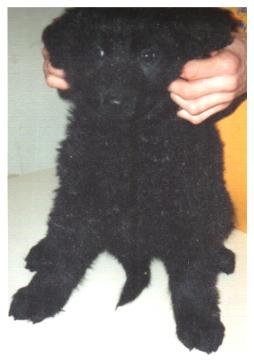
The gene for longcoats seems to be recessive, but I have also received data where two longcoats were bred together,and a forth of the resulting progeny were normal coated,indicating that coat length inheritance may be more complex than the simple dominate/recessive Mendelian law of genetics.
Longcoats may occur in any GSD color or pattern. I have found the "fringe" longcoats to be almost as easy to care for as a normal coat,except for possibly the need to keep the area behind the ears groomed or trimed as this area tends to mat.I also have trimmed the belly,under the tail and pants on a longcoated female prior to whelping for cleanliness and for the pups
I have heard of wire coated GSD's with airedale like whiskers-any pedigree-photo data on this would be welcome. I have seen one picture in a book of such a dog.
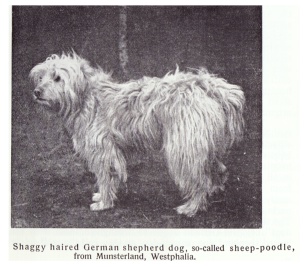
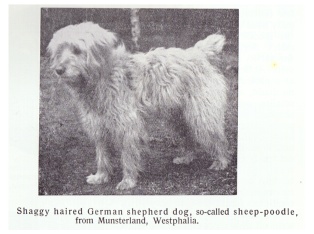
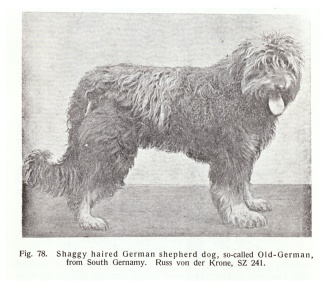
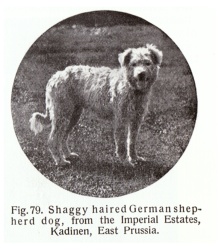
These are pictures of some of the earliest longcoated German Shepherd Dogs in history, when the breed was in its infancy.
The longcoat gene has been in the breed since the breed's beginning. Such dogs as 1925 Sieger Klodo v Boxberg, Odin v Stolzenfels, and Curt v Herzog Hedan carried coat, just to name a few well known historical dogs. Most of the top dogs of the present day do carry the gene for longcoat, as did most of the top dogs throughout the breed's history. Discrimination against the long coats in breeding has been practiced for decades, but has failed to eliminate the gene or even to reduce the frequency with which it occurs or the numbers of influential dogs that carry the gene. I personally feel that there is little point in discriminating against the typical fringe-type longcoat when other factors are so much more important. If a dog is outstanding in most other respects, especially in physical and mental soundness, then it seems trivial to discard that dog merely because its hair is a bit too long and bushy. There are so many major physical and mental traits in the breed to try to improve on and stabilize, traits that influence the dog's physical and mental capabilities and quality of life. We are far from having the best aspects of these major traits stabilized to a point where problematic deviations from the ideal become rare. Until we consistently produce dogs that are to a great degree free of mental and physical unsoundnesses, including hip, elbow, digestive, and temperament problems (just to mention a few of the best known problems that can certainly interfere with the dog's quality of life) then the trivial issues of coat and color should not be given as high a priority as they are in the discriminative process.

This picture shows an adult longcoat of the typical "fringed" type of longcoat and a shortcoated male. The fringe in the picture of the dog on the left, particularly the ear fringe, heavier fringe surrounding the face, and although not pictured, fringe on the backs of legs, between toes, and much heavier pants and tail hair, is the defining factor in determining a longcoat.
I have recently heard of a German Shepherd Dog from respectable bloodlines that has a very long, continuously growing type of coat. This is the first I've personally heard of that particular type of coat in the breed. If anyone has any pedigree data or photo of a dog with this coat type, please e-mail it to [email protected] you
NEW! List of Famous Coat Carriers!
Future Topics
I am working to compile data on other genetic aspects of the GSD,including delayed development{pups that lag greatly behind littermates but end up normal sized adults-taking much longer to grow than the normal GSD.}
[Front Entrance][Photo Gallery][Pedigree's][GSD Coat Colors][Kennel Page]
� 1997 [email protected]
This page hosted by  Get your own Free Home Page
Get your own Free Home Page
